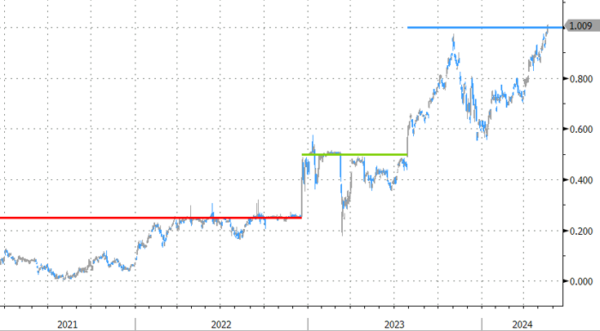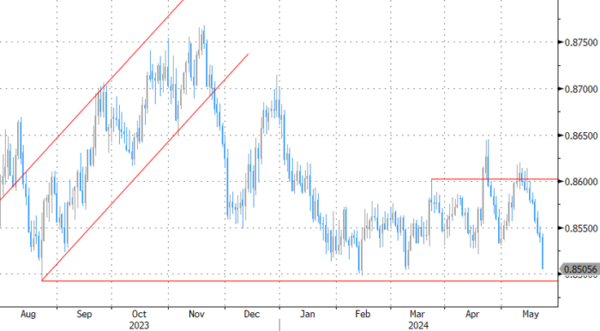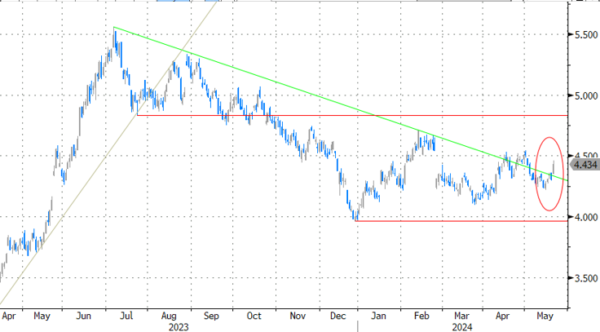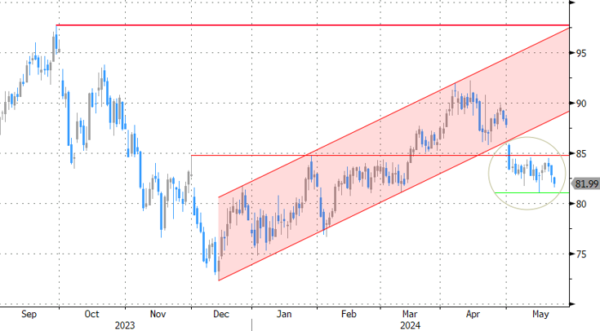Markets
April UK inflation figures set the tone from the start of trading. The Bank of England, with a leading role for chair Bailey, hyped the number way in advance as coming a long way in the direction of the 2% inflation target. That was because of the anticipated drop in the cap on regulated energy prices which would put the UK on a European instead of US-style inflation trajectory. BoE comments were split on following Frankfurt with a June rate cut or keeping rates higher for longer like the Fed. The May policy meeting and report contained arguments for both scenarios. This morning’s inflation report settles the debate and calls for surrender by the BoE Chair. Headline inflation slowed from 0.6% M/M to 0.3% M/M but consensus hoped for a 0.1% outcome. The Y/Y figure slowed from 3.2% to 2.3% instead of 2.1%. The picture becomes more troublesome when looking at core measure. UK core CPI accelerated from 0.6% M/M to 0.9% M/M with the Y/Y-number only retreating from 4.2% to 3.9% instead of 3.6%. Services inflation even came in at an astonishing 1.5% M/M with the annual figure remaining sticky at 5.9% (from 6%). UK markets drew firm conclusions. The market implied probability of a June rate cut fell from roughly 50% to barely 15%. A first cut is now only (completely) discounted by the November (!) BoE policy meeting. UK gilts obviously underperformed German Bunds and US Treasuries. UK yields today rise by 8.9 bps (30-yr) to 12.7 bps (2-yr) compared with 4-5 bps increases in Germany and 3-4 bps gains in the US. Sterling outperformed with EUR/GBP in first instance dropping from 0.8540 to 0.8520, but now gradually looking for a test of the (strong) support zone at 0.85. Cable set a new short term high around 1.2750 before being called back by today’s genuine USD strength (EUR/USD 1.0835). In a broader perspective, today’s UK CPI figures make you wonder whether Europe (alone) can buck the global trend of stickier (core) inflation. Tomorrow’s PMI surveys and Q1 wage data are a first reference. EMU PMI’s showed the EMU economy gradually coming back to live in recent months with price gauges already running at highest levels in (over) a year. Q1 wage numbers will like remain sticky at levels around 4.5% annualized. Put against today’s context, this could cause some further underperformance of the front end of the European curve.
News & Views
Polish sold industrial output, which tends to be very volatile in M/M figures, declined by 2.2% M/M in April but this still lifted the Y/Y-measure to a higher than expected 7.9%. In the period January-April of 2024, production of industry was 0.9% Y/Y. An increase in sold production was reported in 31 (out of 34) industry divisions. Polish employment was unchanged in April from March, but declined 0.4% Y/Y. Average wages eased slightly M/M in April (-1.6% M/M). According to the statistical office, this decrease was due to a higher scale of payments (special payments) in the previous month. Y/Y average wages rose 11.3%, from 12% in March. The rise was marginally softer than expected. In January, the statutory minimum salary was raised by 17.8%. With headline and core inflation in April at respectively 2.4% and 4.1%, Y/Y this still suggests a solid rise in disposable income. The zloty is falling prey to profit taking (EUR/PLN 4.268 from 4.2525) but a similar move is visible in the forint and to a lesser extent in the Czech koruna. Today’s data won’t change assessment of the National bank of Poland that it will keep rates unchanged until the end of the year.
In its monthly report, the Bundesbank indicated that negotiated wages in the first quarter rose 6.2%. The rise was higher than expected. The data suggest that the euro-wide negotiated wage data of the ECB might be higher than expected tomorrow. In a broader analysis of the economy, the Buba also indicated that its expects inflation to rise again in May and to stay at slightly higher level in the coming months. While this is mainly due to base effects, the Buba also warns that there remain risks to the disinflation process because of wage rises.
Graphs
Japanese 10-yr yield rises above 1% for the first time since 2012
EUR/GBP: ready to test 0.85 support on sticky inflation print
UK 2-yr yield tries to break the downward trend with money markets pushing a first rate cut to November
Brent crude testing the recent downside as questions on global growth remain

















